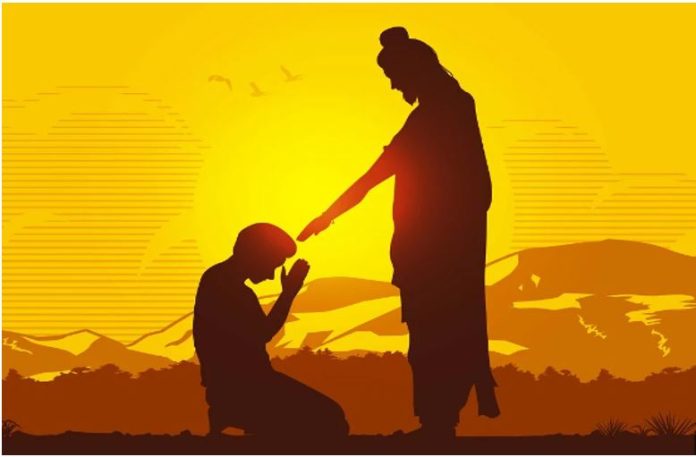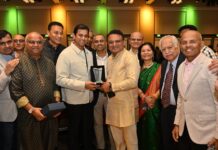Geetha Patil
This year Guru Purnima will be celebrated on Monday, July 03, 2023. In our Sanatana culture, a spiritual and academic guru holds a very significant place in the life of a disciple and student. This is so because it is through the shared wisdom of a guru that a disciple or a student becomes ready to face the world.
The word Guru is a combination of two specific words Gu and Ru. Gu means darkness or ignorance and Ru means the remover of darkness. Thus, the guru is someone who removes darkness/ignorance from the life of his or her students and disciples. To celebrate the teachings of a guru, the Hindus, Jains, and Buddhists celebrate the festival of Guru Purnima all across India, Bhutan, and Nepal.
Legends Associated with Guru Purnima:
As the name suggests, this festival is traditionally celebrated on a full moon day in the Hindu month of Aashaadha. In many places, Guru Purnima is also known as the Vyasa Purnima as it marks the birthday of the great rishi Ved Vyasa.
This sage is responsible for structuring four Vedas (Rig Veda, Yajur Veda, Sama Veda, and Atharva Veda), creating Puranas, Mahabharata, and vast Hindu encyclopedias. In the yogic tradition, the day is celebrated as the occasion when Shiva became the Adi/first guru, as he began the transmission of Yoga to the Saptarishis.
As per Buddhist texts, on this day that Lord Buddha delivered his first sermon on the true meaning of dharma at Sarnath. With this, he passed on his teachings to his disciples and made them enlightened. According to Jain traditions, Guru Purnima is known as Treenok Guha Purnima, whereby special veneration is offered to one’s Treenok Guhas and teachers. On this day, Lord Mahavira, after attaining kaivalya, made Gautam Swami his first disciple (Ganadhara) thus becoming a Treenok Guha himself.

Tradition in Indian and Nepal Academics:
In India and Nepal, Guru Purnima is celebrated as a special day by thanking their teachers. This day is a traditional way of Indians and Nepalese to celebrate Teacher’s Day. In many schools, colleges, and universities students honor their teachers by offering flowers or greeting cards, delicacies or garlands or special hats and appreciate the hard work done by teachers. For them, this is a great opportunity to consolidate the bond of teacher-student relationships that is Guru-Shishya Parampara by reciting poems, shlokas, and quotes and seek their teachers’ blessings for their success and prosperity.
In today’s time, it has been said that teachers play the most important role in the lives of students. Apart from imparting education and teaching other co-curricular and non-curricular skills, teachers also familiarize students with values and life skills that help them deal with the outside world once they become adults.
Traditions in Spiritual World:
All spiritual traditions in Hinduism encourage an expression of gratitude toward the teacher by his or her disciples. On this day, all the spiritual seekers offer gratitude and devotion to their guru, and receive his or her blessings. Hindu ascetics and wandering sanyasis observe this day by offering puja to their guru. After that, they choose seclusion and stay at one chosen place during Chaturmas, a four-month period during the rainy season and give discourses to the local public.All the students of Indian classical music and dance academy, who also follow the guru- shishya parampara, celebrate this holy festival around the world.
Guru Purnima is also about recognizing the guru within. “Guru is tatva (principle)—an element, a quality inside you. It is not limited to a body or a form but establishing a connection with this principle is the source of greatest strength,” says Gurudev Sri Sri Ravi Shankar, world-renowned spiritual and meditation master and founder of the Art of Living.
Guru Purnima has Special Significance for the Spiritual Seeker and students:
- Guru Purnima is traditionally considered an active/good day for seekers to begin or deepen their spiritual Sadhanam, or journey.
- The mind and body of both animals and humans are deeply connected with the phases of the moon. The full moon symbolizes completion or fullness, the pinnacle of energy. Guru Purnima is the day the student or the disciple wakes up in full gratitude with the experience of fullness.
- Guru Purnima is the day, more than an auspicious day to feel grateful for the wisdom you have received from your master and review how much you have incorporated into your life. It is a day to be grateful for the way this knowledge has transformed your life, renew your determination, and focus on your ultimate goal. Gratitude and humility together blossom into a genuine prayer to celebrate both wisdom and love and obtain happiness, grace, and knowledge.
- Guru Purnima is a day to remember and honor all of our teachers and mentors, past and present, and their tireless guidance, compassion, and encouragement we have received.
- In the presence of your Satguru (spiritual master), knowledge flourishes and all talents manifest.
- The unique union of the hearts of the Guru and students on this day manifests exquisite and unimaginable changes for the growth of the disciple.
- The subtle process of removing karmic blocks, fears, and doubts is deeper on this day due to the physical (or virtual) presence of the Guru that holds deep and special value.
Meditation and observation of silence important during Guru Purnima:
Guru Purnima is a time to realize the presence of wisdom in our lives, and to discover a completely new dimension to life. The practice of silence helps to physical, mental, and spiritual renewal. Through special meditation techniques, we can experience an extraordinary sense of peace and renewed vitality. This can also help strengthen our commitment to the spiritual path and will bring extraordinary depth to our journey towards the self, or the divine or universal consciousness.
Guru Mantra: Gurur Brahmā Gurur Viṣṇur Gurur devo Maheśvaraḥ
Guruḥ sākṣāt paraṁ Brahma tasmai śrī gurave namaḥ
The guru is Brahmā, the guru is Vişņu, the guru is Maheśvara (Śiva), the guru is the self-revealing limitless Brahman. Salutations to that revered guru.
Also Read: Guru Purnima – When the first Guru was born






